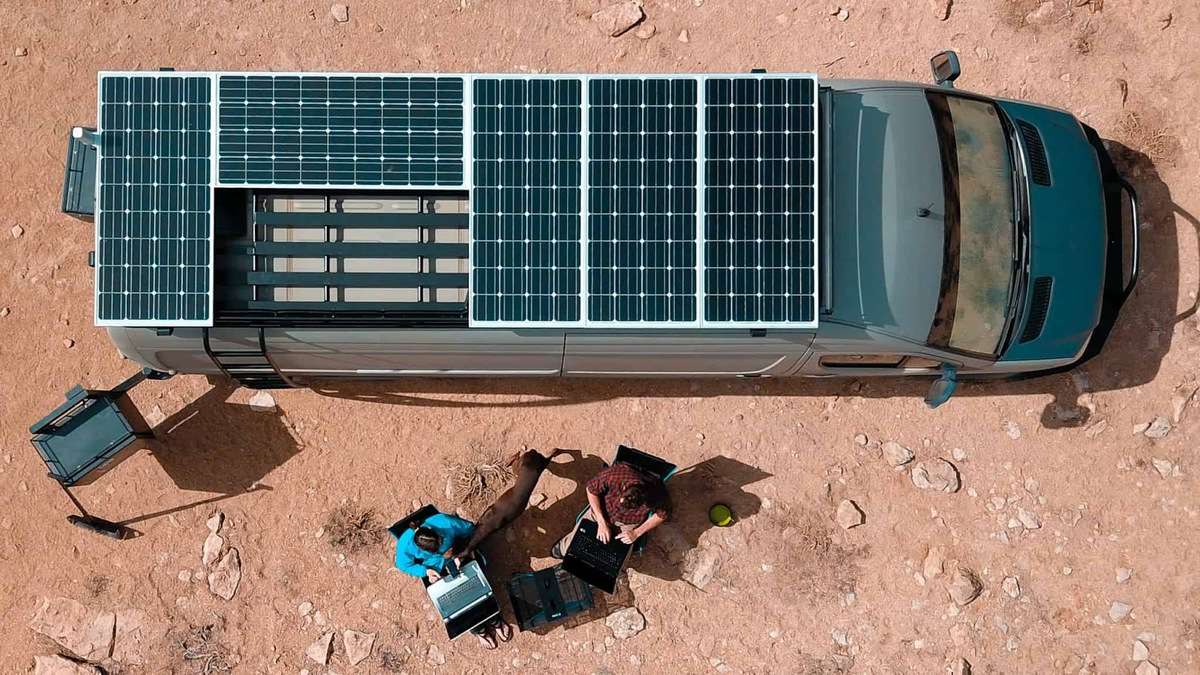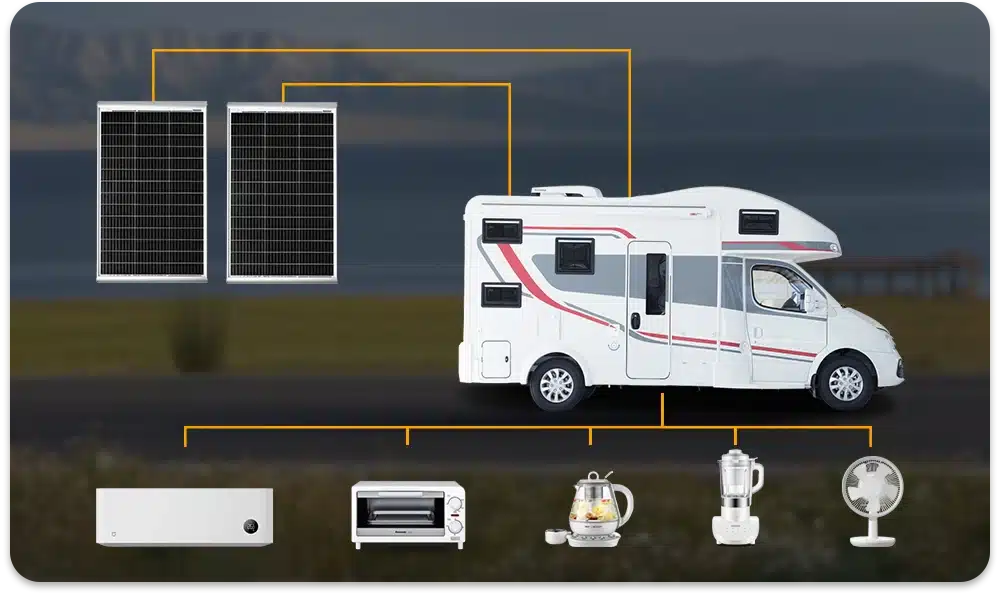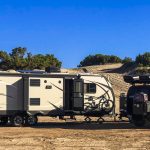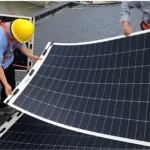Which Option Is More Affordable: Living in an RV or a House?
We all yearn for outdoor travel. It’s important to note that full-time RV living is a great way to travel and explore the world but to be honest, it comes with its own set of expenses. One big question on everyone’s mind is whether the cost of owning an RV in the United States is lower than having a traditional home, or is it the other way around? Given the popularity of RVs these days, people often wonder if living in an RV is cheaper than renting an apartment or a house, and it’s a valid question. When comparing renting an apartment or a house with living in an RV, there are several factors to consider. What factors should you take into account?
In conclusion, RV living is undoubtedly more cost-effective than investing in real estate in the United States. To make RV living even more cost-efficient, you can utilize powerful flexible solar panels that harness free renewable solar energy to charge your appliances. The Sungold TF-200W flexible solar panel is a reliable RV power solution. It not only provides power to outdoor appliances using solar energy for 99% of the time but is also compatible, lightweight, and suitable for RV spaces.

What are the monthly/yearly costs of full-time RV living in the United States?
The monthly living costs of a motorhome in the UK can be influenced by various factors, including the size, model, type, and location of the motorhome. Typically, the cost of purchasing a recreational vehicle (RV) can range from £10,000 to £15,000.
Additionally, you should also consider daily expenses such as maintenance and servicing, fuel, insurance, and so on. The monthly average cost of full-time RV living in the UK generally falls between £1,500 to £3,000.
What are the monthly/yearly costs for homeowners in the United States?
For many homeowners, buying a house is associated with financial freedom and security. However, it comes with substantial initial and ongoing investments. The typical upfront costs of buying a home in the United States are close to $40,559, with an average monthly homeownership cost of $1,558.
The monthly and yearly costs for homeowners in the United States can vary due to several factors, and here are some common cost components:
Monthly Costs:
- **Mortgage Payment**: If you’ve purchased a home with a mortgage, you’ll need to make monthly payments that include both principal and interest.
- **Property Taxes**: Property tax rates vary by location, and homeowners typically pay a portion of their taxes annually or quarterly, which can also be spread out monthly.
- **Home Insurance**: Homeowners typically need to purchase homeowners insurance to protect their homes from damage or disasters, and this cost can be paid on a monthly basis.
- **Maintenance and Repairs**: Regular maintenance and occasional repairs, such as fixing the roof or repairing plumbing, are necessary and may vary depending on needs.
- **Utilities (Water, Electricity, Gas)**: Monthly bills for water, electricity, and gas depend on your usage and the rates set by utility providers.
- **Community Fees**: If you live in an area with a homeowners’ association, you may have to pay monthly or yearly community fees for maintaining common facilities and services.
Yearly Costs:
- **Property Taxes**: Property taxes are typically an annual expense, and it’s crucial to ensure they are paid on time.
- **Home Insurance**: Homeowners need to renew their homeowners insurance annually to keep their coverage active.
- **Renovations and Upgrades**: Homeowners may engage in periodic renovations and upgrades, which are not fixed monthly costs but should be factored in.
Please note that these are some common cost components related to homeownership in the United States, and the specific costs can vary based on factors such as the location of the home, its size, and your lifestyle. Additionally, homeowners should also consider additional expenses like emergency repairs, furnishings, and decor.
It’s important to conduct a detailed budgeting exercise before purchasing a home to ensure you can afford both monthly and yearly expenses. When calculating the monthly or yearly costs of owning a home, it’s essential to understand two types of expenses: one-time costs and ongoing costs. Some one-time costs include the down payment, appraisal fees, inspection fees, and home transfer costs. Ongoing expenses include property taxes, maintenance fees, homeowners insurance, and more.
Clearly, the cost of buying a house is significantly higher than the cost of full-time RV living.
Please note that the costs associated with homeownership in the United States may vary depending on your location and other factors.
What are the essential requirements for full-time RV living?
Before you hit the road and embark on the adventure of full-time RV living, it’s essential to have all the necessary essentials in place. Here, we list the essential resources for both short and long-term RV adventures:
- **Water Purifier**: Having a high-quality water filter ensures you have safe, clean drinking water, cooking water, and bathing water during your RV travels.
- **Sungold Flexible Solar Panels**: Imagine being in the middle of nowhere, your RV running out of fuel, or worse, your phone’s battery dying, and there are no power outlets nearby. It can turn your joyful RV adventure into a hassle. Fortunately, there’s a solution—flexible solar panel systems like Sungold. Sungold flexible solar panels provide a portable and cost-effective way to charge your RV equipment. They consist of Sungold TF series solar panels and RV lithium batteries, absorbing solar energy and converting it into stored electricity for later use.
- **Tools**: An RV is a machine, so you need to carry a basic set of tools for proper maintenance. Additionally, having a basic toolkit allows you to perform essential RV repair tasks on the go.
- **Comfortable Bedding**: In full-time RV living, your RV becomes your new home. You need comfortable bedding and sheets for a good night’s sleep. Ensure you carry some electric blankets for winter warmth and portable power stations to keep the power supply going.
- **Camping Memberships**: There are numerous camping organizations available for RVers in the United States. However, not all are the same. You’ll need to do in-depth research to choose an organization that provides quality resources at an affordable price.
In summary, in most cases, living in an RV is more cost-effective than owning a traditional home. To make RV living even more cost-efficient, you can utilize powerful flexible solar panels to charge your appliances with free renewable solar energy. The Sungold TF-200W is a reliable RV power solution. It not only provides power to outdoor appliances using solar energy for 99% of the time but is also compatible, lightweight, and suitable for RV spaces.
Please note that the cost-effectiveness of RV living compared to traditional homeownership may vary depending on factors such as the RV’s construction and facilities, as well as the location of your travels. RV living offers a sense of freedom, flexibility, and excitement, making it suitable for those who crave adventure and exploration.
What should you do before hitting the road?
Whether you’re hitting the road solo or embarking on the journey with your family, it’s essential to follow clear guidelines to ensure a smooth start to your RV life adventure. Here are some steps to help kickstart your RV life journey:
- **Select the Right-Sized RV**: Many people ask, “How much does an RV cost?” The exact answer depends on the size and type of the RV. When planning, determine the amount you’re willing to invest and explore different sizes and types of RVs that fit within your budget.
- **Master Basic RV Knowledge**: Each RV comes with a user manual, and as an RV owner, it’s crucial to familiarize yourself with your RV. Learn essential skills such as plumbing maintenance, leak repairs, tire changes, and more to ensure you can handle various situations while on the road.
- **Conduct Thorough Research**: Identify popular American campgrounds and RV parks and make advance reservations. Before leaving your permanent residence, get a rough idea of where you plan to stay and for how long.
- **Simplify Your Gear**: You may not need to carry all household appliances into your RV. Therefore, downsizing your equipment is a crucial component of full-time RV living. Prioritize essentials and remove equipment you don’t need to lighten the load and enhance comfort.
- **Create a Checklist**: To prepare for the RV lifestyle, it’s essential to create a checklist that covers all the essential steps. This will help you organize everything and smoothly embrace the challenges of RV living.
Whether you’re taking your first steps into RV life or you’re an experienced RV enthusiast, following these steps can help you better enjoy your RV adventures.
Frequently Asked Questions About Full-Time Living Expenses
What are the hidden costs for homeowners and full-time RV living?
The RV lifestyle comes with its own expenses, including but not limited to insurance, campground fees, maintenance and servicing costs, and fuel expenses. However, the costs of RV living are significantly lower compared to owning a traditional home. Some hidden costs associated with homeownership include mortgage payments, maintenance costs, homeowners insurance, property taxes, and more.
How can I save on my full-time RV expenses?
Some ways to save on full-time RV living expenses include:
- Trying out free camping sites to eliminate costly campground fees.
- Investing in campground memberships that align with your travel lifestyle.
- Investing in flexible solar panel systems for your RV to charge all appliances using free solar energy.
- Staying in one adventurous place for longer periods instead of frequently changing locations.
- Exploring free activities such as enjoying local parks, visiting libraries, and participating in seasonal festivals.
What are the best RV solar panels?
The best RV solar panels have five essential components:
- Solar Cells: These cells can generate power even when partially shaded. PERC A+ grade cells (TF) are among the best available, boasting an efficiency of up to 22.6%.
- Potting (Silicone Encapsulation) Junction Box: This feature ensures that saltwater won’t corrode the electronic components.
- Easy Installation: Panels can be either semi-flexible or rigid with a robust anodized aluminum frame, depending on the application.
- A+ Grade Solar Cell Quality: Cheaper panels often have lower-quality, less efficient cells. In RV applications, space is always precious, so having the most efficient cells is crucial. High-efficiency cells generate more power, especially at lower sun angles.
- Bypass Diodes: These diodes significantly reduce the shading effects often encountered during right turns.
These components make the best RV solar panels efficient and durable for powering your RV and its appliances.
What are the differences between budget RV solar panels and premium RV solar panels?
High-quality, high-performance solar panels will generate more electricity than low-quality ones, especially at different angles of sunlight, with power increases of up to 30%. When determining your solar power needs, an important factor to consider is how many watt-hours or amp-hours of electricity you expect to generate in a 24-hour period.
Let’s assume that your RV is located in an area where there is an average of 5 hours of abundant sunlight per day. This average is calculated based on the seasonal angle of the sun and its position from morning to evening.
A 100-watt solar panel with average-efficiency solar cells can generate 100 watts x 5 hours, which equals 500 watt-hours of electricity in a day. At 13 volts, this is approximately 38 amp-hours per day.
Now, with a 100-watt panel equipped with high-efficiency solar cells, it can generate up to 30% more power, or 100 watts x 6.5 effective hours, which equals 650 watt-hours per day. At 13 volts, this is about 50 amp-hours per day.
For an RV, the difference between 38 amp-hours per day and 50 amp-hours per day is quite significant. If you were to add more panels, such as 400 watts, you would see 152 amp-hours compared to 200 amp-hours, which is a difference of 48 amp-hours. It’s important to note that this simple analysis doesn’t account for the impact of clouds or shading, both of which can further affect these differences. Clearly, the higher the quality of the solar panels, the more electricity you can generate in a day.
What size of solar panels do you need for full-time RV living?
This depends on the power consumption of your RV appliances and the tasks you want to accomplish. Running a radio for an afternoon consumes much less power compared to using a refrigerator, lights, water pump, and a computer for full-time RV living. Sizing a solar system isn’t an exact science, and it’s best to leave some room for adjustment on your solar charge controller to scale up if needed. As they say, you can never have too much power! Having excess power is much more fun than being in the red. There’s a Google Docs spreadsheet available for editing that can help you determine your power needs, which you can find here: [Google Docs Spreadsheet](https://docs.google.com/spreadsheets/d/1CnNTXkCZ6kqdcLZ_kXOVL3F_L_zgdWxvnv8pe7XjC8A/edit?usp=sharing) Of course, feel free to reach out to discuss your needs anytime. We’ve built hundreds of solar systems here and are more than happy to share our knowledge.
Final Thoughts
For all outdoor enthusiasts, living in an RV is an adventurous experience. However, before embarking on this new way of life, you need to be prepared and understand the costs associated with RV living. Additionally, thorough research should be done before choosing a campground, and all essential items should be packed to avoid last-minute surprises. You can also opt to install a suitable set of solar panels on your RV roof to enjoy your travels year-round.








